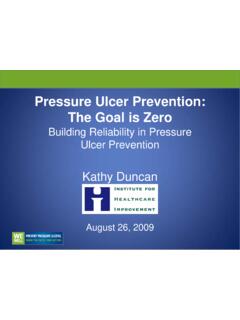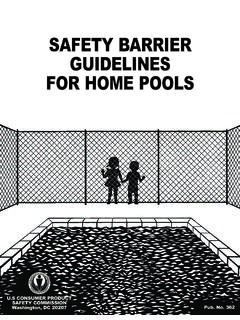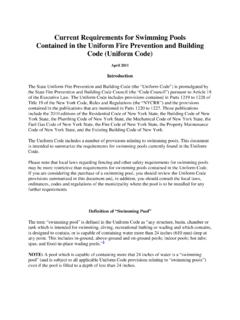Transcription of SPECIAL EVENTS-DOG SWIMS AT PUBLIC SWIMMING POOLS
1 Environmental PUBLIC Health 2 North Meridian Street, 5-E Indianapolis, IN 46204 SPECIAL EVENTS - DOG SWIMS AT PUBLIC SWIMMING POOLS Dog SWIMS , also referred to as drool in the pool or dog days, are SPECIAL events where domestic dogs (pets) are allowed to swim and participate in activities such as cutest dog, most athletic, least athletic, dog tricks, etc at PUBLIC SWIMMING POOLS after the pool season is over. This type of event is growing in popularity and provides another venue for family fun at PUBLIC pool facilities. The purpose of these guidelines is to protect the participants health and safety and to safeguard the pool facilities. The following are some of the health and safety concerns for humans and dogs: Disease transmission from dogs to humans: a. Intestinal infections and internal parasites: Campylobacter, Salmonella, Cryptosporidium and Giardia (very chlorine resistant), Hookworm, Tapeworm, and Roundworm. b. Skin conditions and external parasites: Ticks, Fleas, Ringworm (a contagious fungal skin disease), Sarcoptic Mange (mite that does not reproduce on humans, but will cause a temporary red, itchy rash) c.
2 Some other more rare zoonoses of dogs: Brucella canis, Leptospirosis, rabies (all three are inactivated quickly by properly chlorinated pool water) Safety: bites, scratches, collisions, panicked dogs, drowning? Dog to dog diseases: canine distemper, canine hepatitis, parvovirus, parainfluenza, coronavirus, adenovirus and kennel cough (all are susceptible to properly chlorinated water. Dog to dog contact can transmit these infections and many may contaminate the out of pool environment). People most susceptible to acquiring disease and/or infections would include infants, children under 5, and those with weakened immune systems such as those with HIV/AIDS, cancer, transplants and some inherited conditions. PUBLIC SWIMMING POOLS were designed for human use, so SPECIAL guidelines must be followed to lessen the chance of disease and injury to humans and dogs. 1. Schedule the dog swim only after the regular swim season is over and only at outdoor POOLS .
3 Indoor POOLS would not have accessible areas for dogs to defecate and urinate. The pool should not be used again by humans until it has been properly winterized and re-opened. 2. Raise the residual chlorine level to mg/l (ppm) 24 hours prior to the event. 3. Maintain a residual chlorine level of mg/l (ppm) during the event. The most important factor in disease prevention is maintaining proper chlorine residual. The automatic chlorinator, circulation equipment, especially the skimmers, must operate continuously to remove hair, dirt and other debris. The chlorine residual must be checked before the event opens and at least once during the event. Chlorine level may drop quickly in this kind of event. Do not allow chlorine levels to exceed mg/l as this may adversely affect the dogs. Also, the dogs should be hosed off after the swim to remove any chlorine. 4. Do not allow humans to swim or be in the pool with the dogs. This is the best way to prevent disease transmission to humans and to prevent injuries.
4 5. Use only shallow areas for the events. Some dogs cannot and/or do not like to swim , so facilities such as ramps may be needed to allow dogs to enter and exit the pool. Do not raise the water level as this will inhibit the skimming function of the pool skimmers. The pool skimmers/gutters will return the dirtiest water, which is in the top 1 inch, to the filter. 6. Decks drains must be kept free of hair and debris and drain properly. 7. All dogs must be registered at the event: owner s name and address, license if required, and have current vaccination history. Vaccination at the event will not provide immediate protection. Dogs that are too young to be vaccinated, are more likely to have internal parasites and more likely to have accidents . Aggressive dogs, dogs with obvious infections or diarrhea, or dogs in heat should not be allowed. Also one dog per handler should be allowed. 8. Hose off dogs before allowing them to enter the pool.
5 This will remove excess hair, dirt, feces, urine, etc. 9. Staff must be present who are trained in canine CPR, to treat injuries, monitor dog behavior and to recognize hazards, such as dogs in distress. 2 10. Dog Fecal accidents: In the pool Remove as much of the fecal material as possible with a net and dispose to waste container. Do not use the pool vacuum. The net shall be sanitized with a freshly prepared solution of cool water and household bleach (1 part bleach per 9 parts cool water). Hot water causes the chlorine in the bleach to dissipate too quickly to properly sanitize. Pool deck Remove as much of the fecal material as possible and dispose of properly and then sanitize the area Grassy areas Remove as much of the fecal material as possible and dispose of properly. Some parasites, such as roundworm eggs can remain infectious for months in soil, posing a possible risk to people walking barefoot, eating in the area.
6 Dog to dog pathogens, such as parvo, may also remain infectious in soil for months and could pose a risk to other dogs. 11. Blood and vomit cleanup (human) on surfaces: Follow standard Universal Precautions. 1. Block off the area of the spill from patrons until clean-up and disinfection is complete. 2. Put on disposable latex gloves to prevent contamination of haands. 3. Wipe up the spill using paper towels or absorbent material and place in a plastic garbage bag. 4. Gently pour bleach solution (1 part bleach per 9 parts cool water) onto all contaminated areas of the surface. 5. Let the bleach solution remain on the contaminated area for 20 minutes. 6. Wipe up the remaining bleach solution. 7. All non-disposable cleaning materials used such as mops and scrub brushes should be disinfected by saturating with bleach solution and air dried. 8. Remove gloves and place in plastic garbage bag with all soiled cleaning materials. 9. Double-bag and securely tie-up plastic garbage bags and discard.
7 10. Thoroughly wash hands with soap and water. 12. Rest/relief station Station should be designated, visible, accessible, and Drinking water for dogs Cleanup supplies: Plastic bags, paper towels, alcohol hand sanitizers and any supplies needed for owners to cleanup after their dogs. Rest periods: Plan for periodic resting/relief sessions for the dogs out of the pool, because dogs will tire easily. Engage dogs in a high energy exercise prior to the event to encourage dogs to urinate/defecate before entering the pool. First aid supplies 3 4 13. Dog bites Wash wound immediately with soap and water for 15 minutes, then see physician (humans) or veterinarian (dog-to-dog). Contact your local County Health Department for proper procedures in the event that an animal bite has broken the skin of someone. 14. Service animals used for the purpose of assisting persons with handicaps may not be excluded from PUBLIC areas, so SPECIAL accommodations may be necessary.
8 15. After the event Pool The pool and filters must be superchlorinated to kill any Cryptosporidium before reopening for human SWIMMING next season. Raise the free chlorine level in the pool water to 20 mg/l (ppm) and maintain it at 20 mg/l for seven hundred sixty-five (765) minutes (12 hours 45 minutes), or the length of time necessary to attain a 15,300 contact time value equivalent. Normal winterizing procedures can then be followed. Deck Clean and sanitize Grassy areas Remove as much of the fecal material as possible and dispose of properly Sanitize shall mean: 1 part bleach per 9 parts cool water References: CDC Ohio Department of Health City of Bloomington Parks and Recreation, drool in the pool



















